Best time to buy and sell stock II
Given an array arr of n integers, where arr[i] represents price of the stock on the ith day. Determine the maximum profit achievable by buying and selling the stock any number of times.
Holding at most one share of the stock at any given time is allowed, meaning buying and selling the stock can be done any number of times, but the stock must be sold before buying it again. Buying and selling the stock on the same day is permitted.
Examples:
Input: arr = [9, 2, 6, 4, 7, 3]
Output: 7
Explanation: Buy on day 2 (price = 2) and sell on day 3 (price = 6), profit = 6 - 2 = 4. Then buy on day 4 (price = 4) and sell on day 5 (price = 7), profit = 7 - 4 = 3. Total profit is 4 + 3 = 7.
Input: arr = [2, 3, 4, 5, 6]
Output: 4
Explanation: Buy on day 1 (price = 2) and sell on day 5 (price = 6), profit = 6 - 2 = 4. Total profit is 4.
Input: arr = [8, 6, 5, 4, 3]
Constraints
- 1 <= n<= 105
- 0 <= arr[i] <= 104
Hints
- "Define the DP states as follows: dp[i][0] → Maximum profit on the i-th day without holding a stock. dp[i][1] → Maximum profit on the i-th day while holding a stock."
- Since dp[i] only depends on dp[i-1], we can reduce space complexity from O(n) to O(1) by maintaining only two variables instead of an entire DP table.
Company Tags
Editorial
Upon observation we find that every day, there will be two choices, either to do nothing and move to the next day or to buy/sell (based on the last transaction) and find out the profit. Therefore we need to generate all the choices in order to compare the profit. As we need to try out all the possible choices, we will use recursion.
Steps to form the recursive solution:
f(ind, buy) will give the maximum profit that can be generated from day 'ind' to day (n-1), where 'buy' tells that whether we need to buy or sell the stock at day 'ind'.
- Case 1: When buy == 0, the stock can be bought. If we can buy the stock on a particular day, there will be agian two options:
- Case 2: When buy == 1, we can sell the stock. If we can sell the stock on a particular day, we will have two options:
Option 1: To do no transaction and move to the next day. In this case, the net profit earned will be 0 from the current transaction, and to calculate the maximum profit starting from the next day, we will recursively call f(ind+1,0). As we have not bought the stock, the ‘buy’ variable value will still remain 0, indicating that we can buy the stock the next day.
Option 2: The other option is to buy the stock on the current day. In this case, the net profit earned from the current transaction will be -arr[i]. As we are buying the stock, it means we are giving money out of our pocket, therefore the profit earned is negative. To calculate the maximum profit starting from the next day, we will recursively call f(ind+1,1). As we have bought the stock, the ‘buy’ variable value will change to 1, indicating that we can’t buy and only sell the stock the next day.
Option 1: To do no transaction and move to the next day. In this case, the net profit earned will be 0 from the current transaction, and to calculate the maximum profit starting from the next day, we will recursively call f(ind+1,1). As we have not bought the stock, the ‘buy’ variable value will still remain at 1, indicating that we can’t buy and only sell the stock the next day.
Option 2: The other option is to sell the stock on the current day. In this case, the net profit earned from the current transaction will be +arr[i]. As we are selling the stock, we are putting the money into our pocket, therefore the profit earned is positive. To calculate the maximum profit starting from the next day, we will recursively call f(ind+1,0). As the stock has been sold, the ‘buy’ variable value will change to 0, indicating that we can buy the stock the next day.
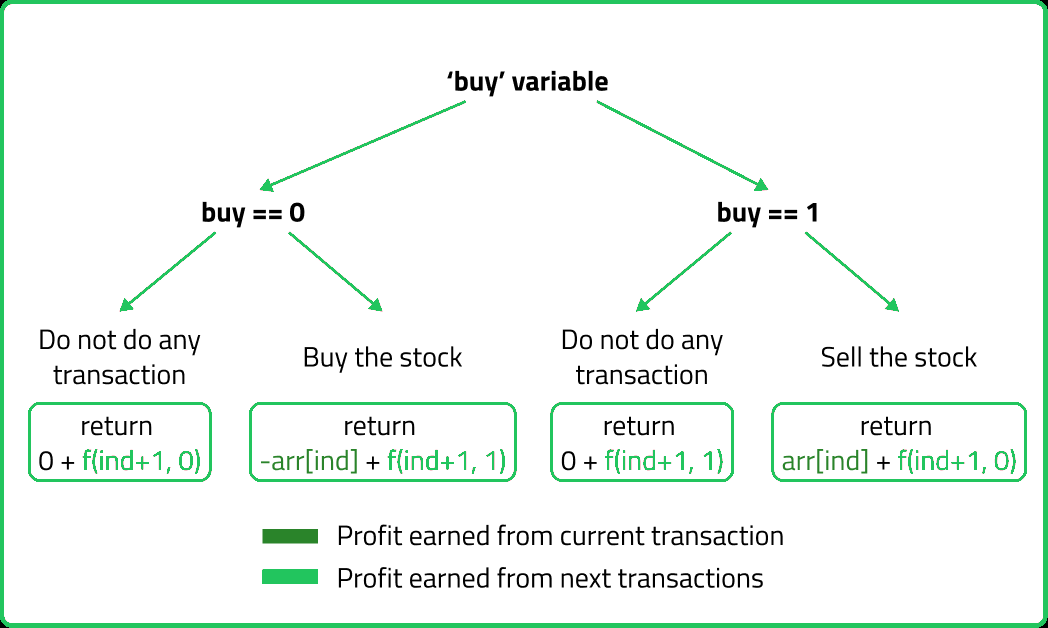
/*It is pseudocode and it is not tied to
any specific programming language*/
f(ind, buy){
//Base case
if(buy == 0){
op1 = 0 + f(ind + 1, 0)
op2 = -arr[ind] + f(ind + 1, 1)
}
if(buy == 1){
op1 = 0 + f(ind + 1, 1)
op2 = arr[ind] + f(ind + 1, 0)
}
}/*It is pseudocode and it is not tied to
any specific programming language*/
f(ind, buy){
//Base case
if(buy == 0){
op1 = 0 + f(ind + 1, 0)
op2 = -arr[ind] + f(ind + 1, 1)
}
if(buy == 1){
op1 = 0 + f(ind + 1, 1)
op2 = arr[ind] + f(ind + 1, 0)
}
return max(op1, op2)
}#include <bits/stdc++.h>
using namespace std;
class Solution{
private:
//Function to find the maximum profit earned using recursion
int func(int ind, int buy, int n, vector<int> &arr) {
// Base case
if (ind == n) {
return 0;
}
int profit = 0;
// We can buy the stock
if (buy == 0) {
profit = max(0 + func(ind + 1, 0, n, arr), (-1)*arr[ind] + func(ind + 1, 1, n, arr));
}
//We can sell the stock
if (buy == 1) {
profit = max(0 + func(ind + 1, 1, n, arr), arr[ind] + func(ind + 1, 0, n, arr));
}
// Return the calculated profit
return profit;
}
public:
//Function to calculate the maximum profit earned
int stockBuySell(vector<int> &arr, int n) {
if (n == 0)
return 0;
int ans = func(0, 0, n, arr);
//Return the maximum profit
return ans;
}
};
int main() {
int n = 6;
vector<int> arr = {7, 1, 5, 3, 6, 4};
//Create an instance of Solution class
Solution sol;
// Call the stockBuySell function and print the result
cout << "The maximum profit that can be generated is " << sol.stockBuySell(arr, n);
return 0;
}
import java.util.*;
class Solution {
// Function to find the maximum profit earned using recursion
private int func(int ind, int buy, int n, int[] arr) {
// Base case
if (ind == n) {
return 0;
}
int profit = 0;
// We can buy the stock
if (buy == 0) {
profit = Math.max(0 + func(ind + 1, 0, n, arr), (-1)*arr[ind] + func(ind + 1, 1, n, arr));
}
// We can sell the stock
if (buy == 1) {
profit = Math.max(0 + func(ind + 1, 1, n, arr), arr[ind] + func(ind + 1, 0, n, arr));
}
// Return the calculated profit
return profit;
}
// Function to calculate the maximum profit earned
public int stockBuySell(int[]arr, int n) {
if (n == 0)
return 0;
int ans = func(0, 0, n, arr);
// Return the maximum profit
return ans;
}
public static void main(String[] args) {
int n = 6;
int[] arr = {7, 1, 5, 3, 6, 4};
// Create an instance of Solution class
Solution sol = new Solution();
// Call the stockBuySell function and print the result
System.out.println("The maximum profit that can be generated is " + sol.stockBuySell(arr, n));
}
}
class Solution:
# Function to find the maximum profit earned using recursion
def func(self, ind, buy, n, arr):
# Base case
if ind == n:
return 0
profit = 0
# We can buy the stock
if buy == 0:
profit = max(0 + self.func(ind + 1, 0, n, arr), (-1)*arr[ind] + self.func(ind + 1, 1, n, arr))
# We can sell the stock
if buy == 1:
profit = max(0 + self.func(ind + 1, 1, n, arr), arr[ind] + self.func(ind + 1, 0, n, arr))
# Return the calculated profit
return profit
# Function to calculate the maximum profit earned
def stockBuySell(self, arr, n):
if n == 0:
return 0
ans = self.func(0, 0, n, arr)
# Return the maximum profit
return ans
if __name__ == "__main__":
n = 6
arr = [7, 1, 5, 3, 6, 4]
# Create an instance of Solution class
sol = Solution()
# Call the stockBuySell function and print the result
print("The maximum profit that can be generated is", sol.stockBuySell(arr, n))
class Solution {
// Function to find the maximum profit earned using recursion
func(ind, buy, n, arr) {
// Base case
if (ind === n) {
return 0;
}
let profit = 0;
// We can buy the stock
if (buy === 0) {
profit = Math.max(0 + this.func(ind + 1, 0, n, arr), (-1)*arr[ind] + this.func(ind + 1, 1, n, arr));
}
// We can sell the stock
if (buy === 1) {
profit = Math.max(0 + this.func(ind + 1, 1, n, arr), arr[ind] + this.func(ind + 1, 0, n, arr));
}
// Return the calculated profit
return profit;
}
// Function to calculate the maximum profit earned
stockBuySell(arr, n) {
if (n === 0)
return 0;
let ans = this.func(0, 0, n, arr);
// Return the maximum profit
return ans;
}
}
function main() {
const n = 6;
const arr = [7, 1, 5, 3, 6, 4];
// Create an instance of Solution class
const sol = new Solution();
// Call the stockBuySell function and print the result
console.log("The maximum profit that can be generated is", sol.stockBuySell(arr, n));
}
main();
Time Complexity: O(2(N)), where N is the number of row. As, for each index, ther are two possible options.
Space Complexity:O(N), at maximum the depth of the recursive stack can go upto N.
If we draw the recursion tree, we will see that there are overlapping subproblems. Hence the DP approaches can be applied to the recursive solution.
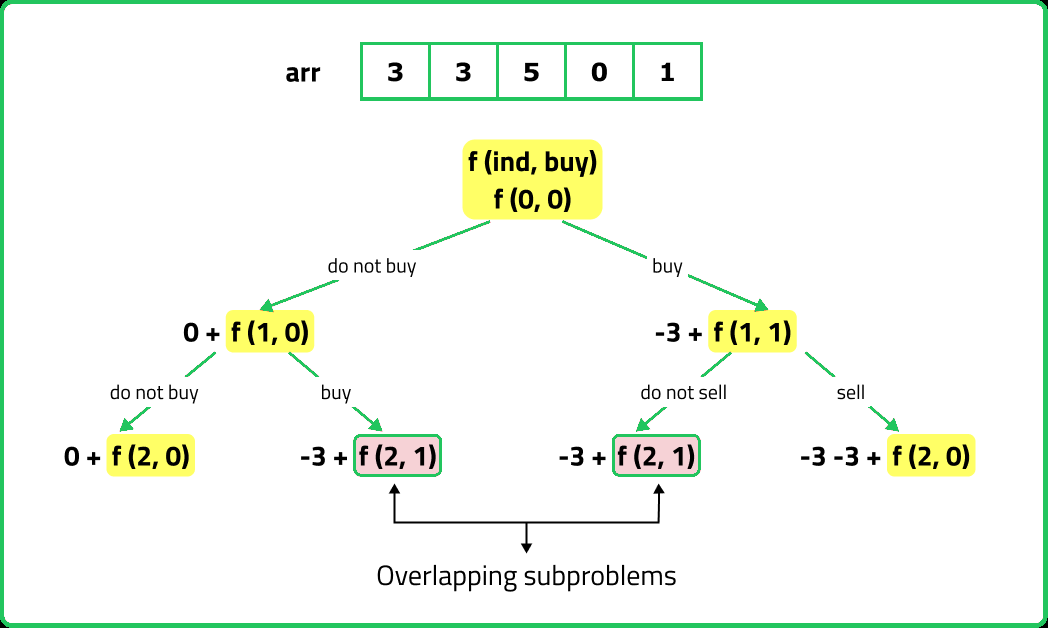
In order to convert a recursive solution to memoization the following steps will be taken:
The dp array stores the calculations of subproblems. Initialize dp array with -1, to indicate that no subproblem has been solved yet.
#include <bits/stdc++.h>
using namespace std;
class Solution{
private:
//Function to find the maximum profit earned using memoization
int func(int ind, int buy, int n, vector<int> &arr, vector<vector<int>> &dp) {
// Base case
if (ind == n) {
return 0;
}
/* If the result for this state has
already been calculated, return it*/
if (dp[ind][buy] != -1) {
return dp[ind][buy];
}
int profit = 0;
// We can buy the stock
if (buy == 0) {
profit = max(0 + func(ind + 1, 0, n, arr, dp), (-1)*arr[ind] + func(ind + 1, 1, n, arr, dp));
}
//We can sell the stock
if (buy == 1) {
profit = max(0 + func(ind + 1, 1, n, arr, dp), arr[ind] + func(ind + 1, 0, n, arr, dp));
}
/* Store the value in dp array and
return the calculated profit */
return dp[ind][buy] = profit;
}
public:
//Function to calculate the maximum profit earned
int stockBuySell(vector<int> &arr, int n) {
if (n == 0)
return 0;
// Initialize a DP table to memoize results
vector<vector<int>> dp(n, vector<int>(2, -1));
int ans = func(0, 0, n, arr, dp);
//Return the maximum profit
return ans;
}
};
int main() {
int n = 6;
vector<int> arr = {7, 1, 5, 3, 6, 4};
//Create an instance of Solution class
Solution sol;
// Call the stockBuySell function and print the result
cout << "The maximum profit that can be generated is " << sol.stockBuySell(arr, n);
return 0;
}
import java.util.*;
class Solution {
// Function to find the maximum profit earned using memoization
private int func(int ind, int buy, int n, int[] arr, int[][] dp) {
// Base case
if (ind == n) {
return 0;
}
/* If the result for this state has
already been calculated, return it*/
if (dp[ind][buy] != -1) {
return dp[ind][buy];
}
int profit = 0;
// We can buy the stock
if (buy == 0) {
profit = Math.max(0 + func(ind + 1, 0, n, arr, dp), (-1)*arr[ind] + func(ind + 1, 1, n, arr, dp));
}
// We can sell the stock
if (buy == 1) {
profit = Math.max(0 + func(ind + 1, 1, n, arr, dp), arr[ind] + func(ind + 1, 0, n, arr, dp));
}
/* Store the value in dp array and
return the calculated profit */
return dp[ind][buy] = profit;
}
// Function to calculate the maximum profit earned
public int stockBuySell(int[] arr, int n) {
if (n == 0)
return 0;
// Initialize a DP table to memoize results
int[][] dp = new int[n][2];
for (int[] row : dp) {
Arrays.fill(row, -1);
}
int ans = func(0, 0, n, arr, dp);
// Return the maximum profit
return ans;
}
public static void main(String[] args) {
int n = 6;
int[] arr = {7, 1, 5, 3, 6, 4};
// Create an instance of Solution class
Solution sol = new Solution();
// Call the stockBuySell function and print the result
System.out.println("The maximum profit that can be generated is " + sol.stockBuySell(arr, n));
}
}
class Solution:
# Function to find maximum profit earned using memoization
def func(self, ind, buy, n, arr, dp):
# Base case
if ind == n:
return 0
""" If the result for this state has
already been calculated, return it"""
if dp[ind][buy] != -1:
return dp[ind][buy]
profit = 0
# We can buy the stock
if buy == 0:
profit = max(0 + self.func(ind + 1, 0, n, arr, dp), (-1)*arr[ind] + self.func(ind + 1, 1, n, arr, dp))
# We can sell the stock
if buy == 1:
profit = max(0 + self.func(ind + 1, 1, n, arr, dp), arr[ind] + self.func(ind + 1, 0, n, arr, dp))
""" Store the value in dp array and
return the calculated profit"""
dp[ind][buy] = profit
return dp[ind][buy]
# Function to calculate the maximum profit earned
def stockBuySell(self, arr, n):
if n == 0:
return 0
# Initialize a DP table to memoize results
dp = [[-1 for _ in range(2)] for _ in range(n)]
ans = self.func(0, 0, n, arr, dp)
# Return the maximum profit
return ans
if __name__ == "__main__":
n = 6
arr = [7, 1, 5, 3, 6, 4]
# Create an instance of Solution class
sol = Solution()
# Call the stockBuySell function and print the result
print("The maximum profit that can be generated is", sol.stockBuySell(arr, n))
class Solution {
// Function to find maximum profit earned using memoization
func(ind, buy, n, arr, dp) {
// Base case
if (ind === n) {
return 0;
}
/* If the result for this state has
already been calculated, return it*/
if (dp[ind][buy] !== -1) {
return dp[ind][buy];
}
let profit = 0;
// We can buy the stock
if (buy === 0) {
profit = Math.max(0 + this.func(ind + 1, 0, n, arr, dp), (-1)*arr[ind] + this.func(ind + 1, 1, n, arr, dp));
}
// We can sell the stock
if (buy === 1) {
profit = Math.max(0 + this.func(ind + 1, 1, n, arr, dp), arr[ind] + this.func(ind + 1, 0, n, arr, dp));
}
/* Store the value in dp array and
return the calculated profit */
dp[ind][buy] = profit;
return dp[ind][buy];
}
// Function to calculate the maximum profit earned
stockBuySell(arr, n) {
if (n === 0)
return 0;
// Initialize a DP table to memoize results
let dp = new Array(n).fill().map(() => new Array(2).fill(-1));
let ans = this.func(0, 0, n, arr, dp);
// Return the maximum profit
return ans;
}
}
const n = 6;
const arr = [7, 1, 5, 3, 6, 4];
// Create an instance of Solution class
const sol = new Solution();
// Call the stockBuySell function and print the result
console.log("The maximum profit that can be generated is", sol.stockBuySell(arr, n));
Complexity Analysis:
Time Complexity: O(N*2), There are N*2 states, therefore at max ‘N*2’ new problems will be solved.Space Complexity:O(N*2) + O(N), As we are using a recursion stack space of O(N) and a 2D array O(N*2).
In order to convert a recursive code to tabulation code, we try to convert the recursive code to tabulation and here are the steps:
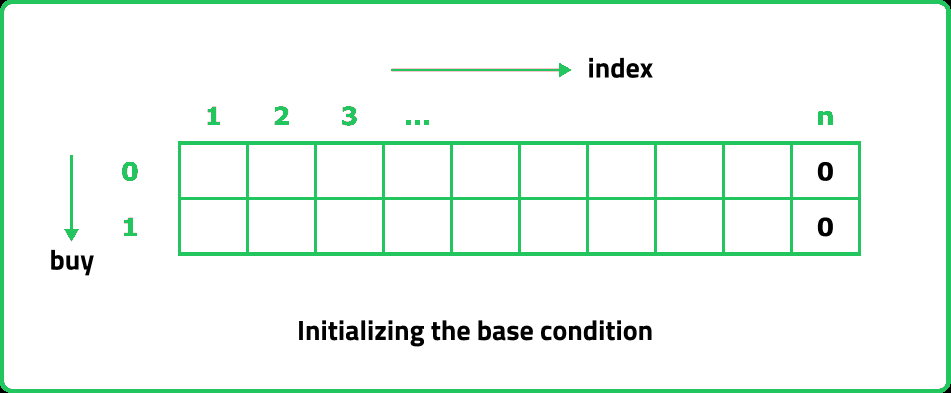
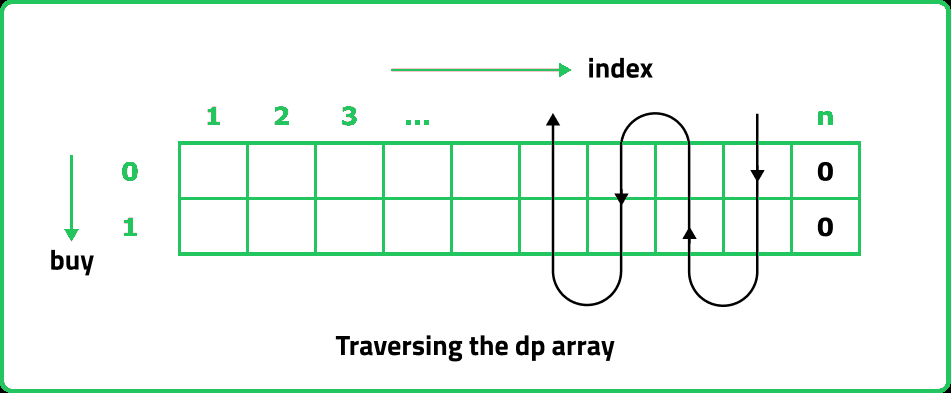
#include <bits/stdc++.h>
using namespace std;
class Solution{
private:
//Function to find maximum profit earned using tabulation
int func(vector<int> &arr, int n) {
// Create a DP table to memoize results
vector<vector<int>> dp(n + 1, vector<int>(2, -1));
// Base condition
dp[n][0] = dp[n][1] = 0;
int profit;
// Loop through the array in reverse order
for (int ind = n - 1; ind >= 0; ind--) {
for (int buy = 0; buy <= 1; buy++) {
// We can buy the stock
if (buy == 0) {
profit = max(0 + dp[ind + 1][0], (-1)*arr[ind] + dp[ind + 1][1]);
}
// We can sell the stock
if (buy == 1) {
profit = max(0 + dp[ind + 1][1], arr[ind] + dp[ind + 1][0]);
}
dp[ind][buy] = profit;
}
}
/* The maximum profit is stored in
dp[0][0] after all calculations*/
return dp[0][0];
}
public:
//Function to calculate the maximum profit earned
int stockBuySell(vector<int> &arr, int n){
//Return the maximum profit
return func(arr, n);
}
};
int main() {
int n = 6;
vector<int> arr = {7, 1, 5, 3, 6, 4};
//Create an instance of Solution class
Solution sol;
// Call the getMaximumProfit function and print the result
cout << "The maximum profit that can be generated is " << sol.stockBuySell(arr, n);
return 0;
}import java.util.*;
class Solution {
// Function to find maximum profit earned using tabulation
private int func(int[] arr, int n) {
// Create a DP table to memoize results
int[][] dp = new int[n + 1][2];
// Base condition
dp[n][0] = dp[n][1] = 0;
int profit = 0;
// Loop through the array in reverse order
for (int ind = n - 1; ind >= 0; ind--) {
for (int buy = 0; buy <= 1; buy++) {
// We can buy the stock
if (buy == 0) {
profit = Math.max(0 + dp[ind + 1][0], (-1)*arr[ind] + dp[ind + 1][1]);
}
// We can sell the stock
if (buy == 1) {
profit = Math.max(0 + dp[ind + 1][1], arr[ind] + dp[ind + 1][0]);
}
dp[ind][buy] = profit;
}
}
/* The maximum profit is stored in
dp[0][0] after all calculations*/
return dp[0][0];
}
// Function to calculate the maximum profit earned
public int stockBuySell(int[] arr, int n){
// Return the maximum profit
return func(arr, n);
}
public static void main(String[] args) {
int n = 6;
int[] arr = {7, 1, 5, 3, 6, 4};
// Create an instance of Solution class
Solution sol = new Solution();
// Call the stockBuySell function and print the result
System.out.println("The maximum profit that can be generated is " + sol.stockBuySell(arr, n));
}
}
class Solution:
# Function to find maximum profit earned using tabulation
def func(self, arr, n):
# Create a DP table to memoize results
dp = [[-1 for _ in range(2)] for _ in range(n + 1)]
# Base condition
dp[n][0] = dp[n][1] = 0
# Loop through the array in reverse order
for ind in range(n - 1, -1, -1):
for buy in range(2):
# We can buy the stock
if buy == 0:
profit = max(0 + dp[ind + 1][0], (-1)*arr[ind] + dp[ind + 1][1])
# We can sell the stock
if buy == 1:
profit = max(0 + dp[ind + 1][1], arr[ind] + dp[ind + 1][0])
dp[ind][buy] = profit
""" The maximum profit is stored in
dp[0][0] after all calculations"""
return dp[0][0]
# Function to calculate the maximum profit earned
def stockBuySell(self, arr, n):
# Return the maximum profit
return self.func(arr, n)
if __name__ == "__main__":
n = 6
arr = [7, 1, 5, 3, 6, 4]
# Create an instance of Solution class
sol = Solution()
# Call the stockBuySell function and print the result
print("The maximum profit that can be generated is", sol.stockBuySell(arr, n))
class Solution {
// Function to find maximum profit earned using tabulation
func(arr, n) {
// Create a DP table to memoize results
let dp = new Array(n + 1).fill().map(() => new Array(2).fill(-1));
// Base condition
dp[n][0] = dp[n][1] = 0;
let profit;
// Loop through the array in reverse order
for (let ind = n - 1; ind >= 0; ind--) {
for (let buy = 0; buy <= 1; buy++) {
// We can buy the stock
if (buy === 0) {
profit = Math.max(0 + dp[ind + 1][0], (-1)*arr[ind] + dp[ind + 1][1]);
}
// We can sell the stock
if (buy === 1) {
profit = Math.max(0 + dp[ind + 1][1], arr[ind] + dp[ind + 1][0]);
}
dp[ind][buy] = profit;
}
}
/* The maximum profit is stored in
dp[0][0] after all calculations*/
return dp[0][0];
}
// Function to calculate the maximum profit earned
stockBuySell(arr, n) {
// Return the maximum profit
return this.func(arr, n);
}
}
function main() {
const n = 6;
const arr = [7, 1, 5, 3, 6, 4];
// Create an instance of Solution class
const sol = new Solution();
// Call the stockBuySell function and print the result
console.log("The maximum profit that can be generated is", sol.stockBuySell(arr, n));
}
main();
Complexity Analysis:
Time Complexity: O(N*2), As, here are two nested loops that account for O(N*2) complexity.Space Complexity:O(N*2), As a 2D array of size N*2 is used.
If we observe the relation obtained in the tabulation, dp[ind][buy] = max( dp[ind+1][buy] , max( dp[ind+1][!buy]), we see that to calculate a value of a cell of the dp array, only the next column values are needed(say ahead). So, we don’t need to store an entire 2-D array. Hence the tabulation code can be space optimized.
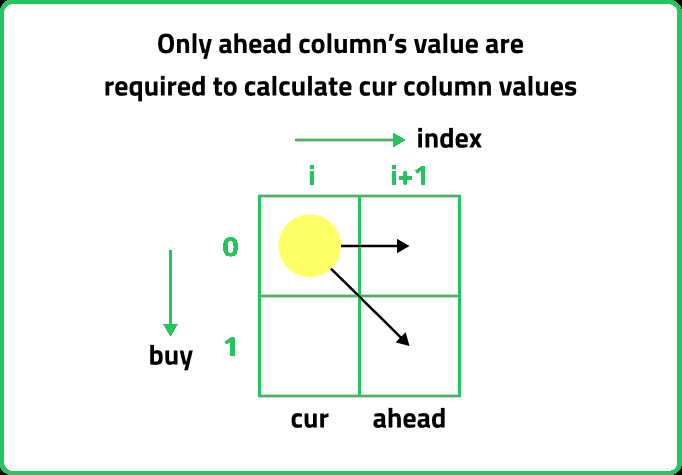
The Steps to space optimize the tabulation approach are as follows:
#include <bits/stdc++.h>
using namespace std;
class Solution{
private:
//Function to find maximum profit using space optimization
int func(vector<int> &arr, int n) {
/* Declare two arrays to store the profits ahead of
current position (0 for not holding, 1 for holding)*/
vector<long> ahead(2, 0);
vector<long> cur(2, 0);
// Base condition
ahead[0] = ahead[1] = 0;
int profit;
// Loop through the array in reverse order
for (int ind = n - 1; ind >= 0; ind--) {
for (int buy = 0; buy <= 1; buy++) {
// We can buy the stock
if (buy == 0) {
profit = max(0 + ahead[0], (-1)*arr[ind] + ahead[1]);
}
// We can sell the stock
if (buy == 1) {
profit = max(0 + ahead[1], arr[ind] + ahead[0]);
}
cur[buy] = profit;
}
// Update the "ahead" array with the current values
ahead = cur;
}
// Maximum profit is stored in cur[0]
return cur[0];
}
public:
//Function to find out the maximum profit earned
int stockBuySell(vector<int> &arr, int n){
//Return the maximum profit
return func(arr, n);
}
};
int main() {
int n = 6;
vector<int> arr = {7, 1, 5, 3, 6, 4};
//Create an instance of Solution class
Solution sol;
// Call the getMaximumProfit function and print the result
cout << "The maximum profit that can be generated is " << sol.stockBuySell(arr, n);
return 0;
}
import java.util.*;
class Solution {
// Function to find maximum profit using space optimization
private int func(int[] arr, int n) {
/* Declare two arrays to store the profits ahead of
current position (0 for not holding, 1 for holding)*/
int[] ahead = new int[2];
int[] cur = new int[2];
// Base condition
ahead[0] = ahead[1] = 0;
int profit = 0;
// Loop through the array in reverse order
for (int ind = n - 1; ind >= 0; ind--) {
for (int buy = 0; buy <= 1; buy++) {
// We can buy the stock
if (buy == 0) {
profit = Math.max(0 + ahead[0], (-1)*arr[ind] + ahead[1]);
}
// We can sell the stock
if (buy == 1) {
profit = Math.max(0 + ahead[1], arr[ind] + ahead[0]);
}
cur[buy] = profit;
}
// Update the "ahead" array with the current values
ahead = cur;
}
// Maximum profit is stored in cur[0]
return cur[0];
}
// Function to calculate the maximum profit earned
public int stockBuySell(int[] arr, int n){
// Return the maximum profit
return func(arr, n);
}
public static void main(String[] args) {
int n = 6;
int[] arr = {7, 1, 5, 3, 6, 4};
// Create an instance of Solution class
Solution sol = new Solution();
// Call the stockBuySell function and print the result
System.out.println("The maximum profit that can be generated is " + sol.stockBuySell(arr, n));
}
}
class Solution:
# Function to find maximum profit using space optimization
def func(self, arr, n):
"""Declare two arrays to store the profits ahead of
current position (0 for not holding, 1 for holding)"""
ahead = [0, 0]
cur = [0, 0]
# Base condition
ahead[0] = ahead[1] = 0
# Loop through the array in reverse order
for ind in range(n - 1, -1, -1):
for buy in range(2):
# We can buy the stock
if buy == 0:
profit = max(0 + ahead[0], (-1)*arr[ind] + ahead[1])
# We can sell the stock
if buy == 1:
profit = max(0 + ahead[1], arr[ind] + ahead[0])
cur[buy] = profit
# Update the "ahead" array with the current values
ahead = cur[:]
# Maximum profit is stored in cur[0]
return cur[0]
# Function to calculate the maximum profit earned
def stockBuySell(self, arr, n):
# Return the maximum profit
return self.func(arr, n)
if __name__ == "__main__":
n = 6
arr = [7, 1, 5, 3, 6, 4]
# Create an instance of Solution class
sol = Solution()
# Call the stockBuySell function and print the result
print("The maximum profit that can be generated is", sol.stockBuySell(arr, n))
class Solution {
// Function to find maximum profit using space optimization
func(arr, n) {
/* Declare two arrays to store the profits ahead of
current position (0 for not holding, 1 for holding)*/
let ahead = [0, 0];
let cur = [0, 0];
// Base condition
ahead[0] = ahead[1] = 0;
let profit;
// Loop through the array in reverse order
for (let ind = n - 1; ind >= 0; ind--) {
for (let buy = 0; buy <= 1; buy++) {
// We can buy the stock
if (buy === 0) {
profit = Math.max(0 + ahead[0], (-1)*arr[ind] + ahead[1]);
}
// We can sell the stock
if (buy === 1) {
profit = Math.max(0 + ahead[1], arr[ind] + ahead[0]);
}
cur[buy] = profit;
}
// Update the "ahead" array with current values
ahead[0] = cur[0];
ahead[1] = cur[1];
}
// Maximum profit is stored in ahead[0]
return ahead[0];
}
// Function to calculate the maximum profit earned
stockBuySell(arr, n) {
// Return the maximum profit
return this.func(arr, n);
}
}
function main() {
const n = 6;
const arr = [7, 1, 5, 3, 6, 4];
// Create an instance of Solution class
const sol = new Solution();
// Call the stockBuySell function and print the result
console.log("The maximum profit that can be generated is", sol.stockBuySell(arr, n));
}
main();
Complexity Analysis:
Time Complexity: O(N*2), As, here are two nested loops that account for O(N*2) complexity.Space Complexity:O(1), As we are using an external array of size ‘2’.
Frequently Occurring Doubts
Q: Why is there a -arr[i] in the dp[i][1] transition?
A: The -arr[i] accounts for the cost of buying the stock. When transitioning from a "not holding" state to a "holding" state, we deduct the stock price to reflect the expense.
Q: How does this differ from the case where we can only make one transaction?
A: With only one transaction, we only track the minimum price seen so far and compute the maximum profit in one pass. With multiple transactions, we must explicitly track when to buy and sell repeatedly, which requires DP.
Interview Followup Questions
Q: How would the solution change if we were allowed at most k transactions?
A: If k transactions are allowed, we extend the DP state to dp[i][j][0] and dp[i][j][1], where j represents the number of transactions used. This leads to a DP table with O(n × k) complexity, often optimized using a rolling array or Kadane-like approach.
Q: Can we solve this problem using a graph-based approach?
A: Yes! The problem can be modeled as a graph, where each node represents a state (holding or not), and edges correspond to buying/selling actions. A shortest path algorithm can then determine the optimal sequence of trades.
Notes
Code
7
4
0
Facts
- • This problem is a classic example of a scenario in algorithmic trading software, which is extensively used in finance and investment fields
- • Such software helps make data-driven decisions and automate multiple trades; they can execute more efficient trades than a human trader
- • The ability to detect and leverage profit-making opportunities like the one described in this problem is a critical function in these systems
- • The problem is essentially defining the peak-valley approach, a common practice in trend-following trading strategies
- • Algorithmic trading systems use similar logic but on a much more complex and vast scale
- • They often include elements like volatility prediction, pattern recognition, and high-frequency trading